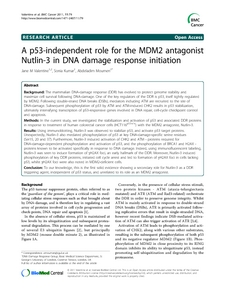Valentine, JM; Kumar, S; Moumen, A
(2011)
A p53-independent role for the MDM2 antagonist Nutlin-3 in DNA damage response initiation.
BMC CANCER, 11 (79).
ISSN 1471-2407
https://doi.org/10.1186/1471-2407-11-79
SGUL Authors: Moumen, Abdeladim
![[img]](https://openaccess.sgul.ac.uk/1209/1.hassmallThumbnailVersion/1471-2407-11-79.pdf)  Preview |
|
["document_typename_application/pdf; charset=binary" not defined]
Published Version
Download (688kB)
| Preview
|
Abstract
BACKGROUND: The mammalian DNA-damage response (DDR) has evolved to protect genome stability and maximize cell survival following DNA-damage. One of the key regulators of the DDR is p53, itself tightly regulated by MDM2. Following double-strand DNA breaks (DSBs), mediators including ATM are recruited to the site of DNA-damage. Subsequent phosphorylation of p53 by ATM and ATM-induced CHK2 results in p53 stabilization, ultimately intensifying transcription of p53-responsive genes involved in DNA repair, cell-cycle checkpoint control and apoptosis.
METHODS: In the current study, we investigated the stabilization and activation of p53 and associated DDR proteins in response to treatment of human colorectal cancer cells (HCT116p53+/+) with the MDM2 antagonist, Nutlin-3.
RESULTS: Using immunoblotting, Nutlin-3 was observed to stabilize p53, and activate p53 target proteins. Unexpectedly, Nutlin-3 also mediated phosphorylation of p53 at key DNA-damage-specific serine residues (Ser15, 20 and 37). Furthermore, Nutlin-3 induced activation of CHK2 and ATM - proteins required for DNA-damage-dependent phosphorylation and activation of p53, and the phosphorylation of BRCA1 and H2AX - proteins known to be activated specifically in response to DNA damage. Indeed, using immunofluorescent labeling, Nutlin-3 was seen to induce formation of γH2AX foci, an early hallmark of the DDR. Moreover, Nutlin-3 induced phosphorylation of key DDR proteins, initiated cell cycle arrest and led to formation of γH2AX foci in cells lacking p53, whilst γH2AX foci were also noted in MDM2-deficient cells.
CONCLUSION: To our knowledge, this is the first solid evidence showing a secondary role for Nutlin-3 as a DDR triggering agent, independent of p53 status, and unrelated to its role as an MDM2 antagonist.
| Item Type: |
Article
|
| Additional Information: |
© 2011 Valentine et al; licensee BioMed Central Ltd. This is an Open Access article distributed under the terms of the Creative Commons Attribution License (http://creativecommons.org/licenses/by/2.0), which permits unrestricted use, distribution, and reproduction in any medium, provided the original work is properly cited. |
| Keywords: |
Animals, Cells, Cultured, DNA Damage, Gene Expression Regulation, Gene Knockdown Techniques, HCT116 Cells, Humans, Imidazoles, Mice, Models, Biological, Phosphorylation, Piperazines, Protein Stability, Protein-Serine-Threonine Kinases, Proto-Oncogene Proteins c-mdm2, Tumor Suppressor Protein p53, Science & Technology, Life Sciences & Biomedicine, Oncology, HUMAN P53, NEGATIVE REGULATION, IONIZING-RADIATION, ACTIVATION, PHOSPHORYLATION, ATM, STABILIZATION, APOPTOSIS, DEGRADATION, MUTATIONS |
| Journal or Publication Title: |
BMC CANCER |
| ISSN: |
1471-2407 |
| Related URLs: |
|
| Web of Science ID: |
WOS:000288016100001 |
| Dates: |
| Date |
Event |
| 2011-02-21 |
Published |
|
  |
Download EPMC Full text (PDF)
|
 |
Download EPMC Full text (HTML)
|
| URI: |
https://openaccess.sgul.ac.uk/id/eprint/1209 |
| Publisher's version: |
https://doi.org/10.1186/1471-2407-11-79 |
Statistics
Item downloaded times since 30 Apr 2012.
Actions (login required)
 |
Edit Item |



